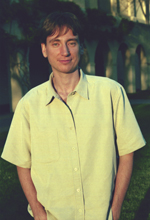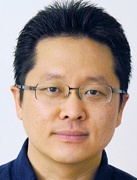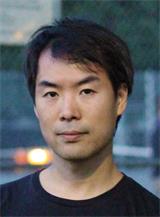Voronoi Diagrams, Delaunay Triangulations, and Beyond: the Power of Simple Geometric Notions
Mathieu Desbrun, Professor, California Institute of Technology, USA
Abstract
The notion of Voronoi diagram (and its dual, Delaunay triangulation) involves a very simple and intuitive geometric construction. Yet,
these simple partitions have found applications in a variety of scientific fields for several centuries. In this talk I will discuss an extension (called power diagram) that has recently been shown particularly relevant
in Computer Graphics. A number of applications, from the design of sampling patterns, to generalized barycentric coordinates, fluid dynamics, and even self-supporting masonry structures will be used to illustrate the generality
of this rich geometric notion.
Bio
Mathieu Desbrun is the Carl F. Braun Professor at the California Institute of Technology (Caltech), where he leads
the Applied Geometry lab, focusing on discrete differential modeling (i.e., the development of differential, yet readily discretizable foundations for computational modeling) and a wide spectrum
of applications, ranging from discrete geometry processing and high-dimensional data analysis, to solid and fluid mechanics as well as field theory. He is the recipient of an ACM SIGGRAPH New Significant
Researcher award and of a NSF CAREER award, and is the founding chair of the the Computing + Mathematical Sciences department at Caltech. Most recently, he chaired the Technical Papers program for ACM SIGGRAPH
2018.

Capturing and Rendering the World of Materials
Wenzel Jakob, Assistant Professor, École Polytechnique Fédérale de Lausanne (EPFL), Switzerland
Abstract
One of the key ingredients of any realistic rendering system is a description of the way in which light interacts with objects, typically modeled via the Bidirectional Reflectance Distribution Function
(BRDF). Unfortunately, real-world BRDF data remains extremely scarce due to the difficulty of acquiring it: a BRDF measurement requires scanning a four-dimensional domain at high resolution- an infeasibly time-consuming process.
In this talk, I'll showcase our ongoing work on assembling a large library of materials including including metals, fabrics, organic substances like wood or plant leaves, etc. The key idea to work around the curse of dimensionality
is an adaptive parameterization, which automatically warps the 4D space so that most of the volume maps to “interesting” regions. Starting with a review of BRDF models and microfacet theory, I'll explain the new model, as well as the optical measurement apparatus that we used to conduct the measurements.
Bio
Wenzel Jakob is an assistant professor at EPFL’s School of Computer and Communication Sciences, where he leads the Realistic Graphics Lab (https://rgl.epfl.ch/). His research interests revolve around material appearance modeling,
rendering algorithms, and the high-dimensional geometry of light paths. Wenzel Jakob is also the lead developer of the Mitsuba renderer, a research-oriented rendering system, and one of the authors of the third edition of “Physically Based Rendering: From Theory To Implementation". (http://pbrt.org/)

Beyond Human Vision - Seeing More with Camera
Min H. Kim, Chair Professor, KAIST, Korea
Abstract
Since the introduction of conventional color cameras to the world, a variety of color imaging technologies have been developed to record as faithful human color perception as possible.
Recent advances in computational imaging have expanded the range of camera functions, enabling us to capture information beyond human vision, such as spectra. Hyperspectral imaging extends the range of imaging
applications by enabling physically meaningful image acquisition with a camera. This talk discusses the foundations of compressive spectral imaging and introduces recent advances in the development of hyperspectral
imaging technology that has been developed to make spectral imaging more accurate and smaller for practical applications in our daily life. Finally, we will discuss future challenges.
Bio
Min H. Kim is a KAIST-Endowed Chair Professor of Computer Science at KAIST, Korea, leading the Visual Computing Laboratory (VCLAB). Before coming to KAIST, he had been a postdoctoral
researcher at Yale University, working on hyperspectral 3D imaging. He received his Ph.D. in computer science from University College London (UCL) in 2010, with a focus on HDR color reproduction for high-fidelity
computer graphics. In addition to serving on international program committees, e.g., ACM SIGGRAPH Asia, Eurographics (EG), Pacific Graphics (PG), and IEEE ICCV, he has worked as an associate editor of ACM
Transactions on Graphics (TOG), ACM Transactions on Applied Perception (TAP), and Elsevier Computers and Graphics (CAG). His recent research interests include a wide variety of computational imaging in the field
of computational photography, hyperspectral imaging, BRDF acquisition, and 3D imaging.

Interactive Design Optimization in Computational Fabrication
Nobuyuki Umetani, Project Lecturer, The University of Tokyo, Japan
Abstract
Designing functional 3D objects today continue to be a time-consuming task. The designer needs to carefully optimize the objects' performance, which often can be evaluated through the expensive simulation. Leveraging the power of machine learning, we can now drastically accelerate various kinds of simulations for 3D shape designs. Based on the prior real-world or simulation examples for various existing shapes, machine learning can instantly synthesize simulation results for a novel input shape. In this talk, I describe several interactive approaches to integrate physical simulation into geometric modeling to actively support creative design processes. Importance of interactivity in the design system will be discussed in various practical contexts including structurally robust design, musical instrument design, garment design, electric circuit design, and aerodynamic design.
Bio
Nobuyuki Umetani is a project lecturer at the University of Tokyo. Previously, he was a research scientist at Autodesk Research, leading the Design and Fabrication group. He was a postdoctoral researcher at Autodesk Research and Disney Research Zurich. He received his Ph.D. degree in 2012 from The University of Tokyo under the supervision of Takeo Igarashi. He also spent one year at Columbia University and in TU Delft, and spent three months in Microsoft Research Asia and in UCL. He won the Microsoft Research Asia fellowship in 2011 and AsiaGraphics Young Researcher Award in 2018. The principal research question he addresses through his studies is: how to integrate real-time physical simulation into an interactive geometric modeling procedure to facilitate creativity. He is broadly interested in physics simulation, especially the finite element method, applied for computer animation, biomechanics, and mechanical engineering. He serves as an associate editor of the Visual Computer journal.
